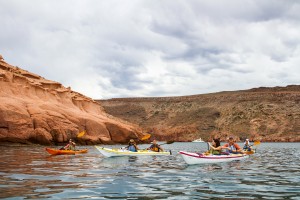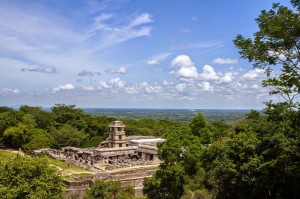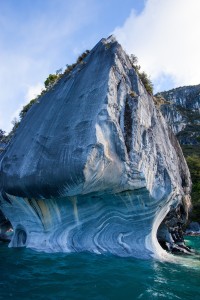
Photo © Hassen Salum
2014 was a very good year for tourism. International tourist arrivals grew 4.7% worldwide according to the latest UNWTO World Tourism Barometer. The Americas demonstrated consistent growth as well, with North America leading with 8%. The best news was for Central and South America. Both registered a growth of 6%, with some destinations growing at double the rate of 2013 (Ecuador +14%, Argentina +18%, Mexico +20.5%).
For the adventure tourism sector in Latin America this represents both an opportunity and a challenge. Latin American countries have found a niche to launch new destinations and activities that appeal to adventure travelers looking for unique, incomparable experiences. But, how much is too much?
“The goal is not to keep growing at the 14% rate registered in 2014, but to grow with the average spending of a more sophisticated tourist,” says Cristina Rivadeneira, Undersecretary of Markets of the Ministry of Tourism of Ecuador.
The challenge is to develop top-notch adventure tourism products that attract visitors who will spend more, stay longer, and appreciate and respect Ecuador’s naturals resources and culture. The very nature of adventure tourism is allowing Ecuador to position new destinations -- beyond the well-known Galapagos -- in the minds of adventure travelers. Adventure travel in Ecuador should also mean the Cotopaxi region, the Andean cloud forest and the Amazon rainforest. The Ministry of Tourism is working closely with local operators to develop products that can highlight the adventure activities that Ecuador’s natural resources allow.

Photo © Hassen Salum
The challenge is huge, but Ecuador is doing all the right things. According to Cristian Mera, Undersecretary of Development of the Ministry of Tourism of Ecuador, they are riding the wave of all the trends to position Ecuador as a top destination for adventure travelers, but they are doing it from the inside out. Among the key actions they are undertaking is the implementation of new regulations that will allow the ministry of tourism to work more closely with the private sector in the regularization and development of new tourism products and a training program for local tour operators and guides. The goal is to empower the adventure tourism sector to allow service providers to offer a higher quality product that generates more revenue.
Something similar is happening in Peru. Even though the country is mostly positioned for its cultural appeal and archeology, in the past years, PROMPERU (Commission of Promotion for Trade and Tourism of Peru) has worked hand-in-hand with the local tour operators to expand and develop the adventure-related products on offer. Proof of this is that Peru has been chosen, for second year in a row, as one of the top five adventure destinations to visit by Virtuoso.
According to Giuliana Valle Conroy, PROMPERU’s PR specialist, Peru has been working closely with international associations like the ATTA and local associations like APTAE (Peruvian Association of Adventure Tourism, Ecotourism and Specialized Tourism) to train guides and tour operators and to develop new adventure destinations.
These new off-the-beaten-path destinations are being developed as routes designed to promote the best of each region of the country with adventure activities that complement the journey. An example is the bird watching route, which includes many of the most remote communities in each region. These routes are a complement to Peru’s traditional tourism products, like Cuzco and Machu Picchu, and are the result of the creativity of local operators, who bet on new adventure routes, and the hard work that PROMPERU has done creating incentives to local service providers and operators.
The same work to diversify adventure tourism offerings in Latin America is being done in Mexico. Over the past five years, adventure has been an intrinsic piece of the Mexico Tourism Board’s annual plans. The adventure tourism sector has seen an increase of interest from the domestic industry since the Adventure Travel World Summit was held in Chiapas in 2011. Stakeholders that used to consider adventure as just a complement to more traditional itineraries are now betting on adventure as an integral tourism product.

Photo © Cameron L. Martindell
A great part of this has been the intensive product development work that destinations that were not known as sun and beach or cultural destinations, have done. Places like Veracruz, Chiapas, Oaxaca, Chihuahua, Baja Sur, Jalisco, among others, have found that adventure travel can be a tool for sustainable and responsible tourism growth. An example of this is Baja California Sur hosting AdventureWeek in March 2015, during which international tour operators came to see for themselves all the adventure possibilities available in the region.
With the support of SECTUR (Mexico’s Ministry of Tourism) and ATTA, Mexico now hosts an annual trade show focused on Adventure Travel sector: ATMEX (Adventure Travel Mexico). Now in its fourth year, ATMEX has become a key component on the growth of adventure oriented tourism products in the country.
Another destination on this path is Chile. The tourism industry for this country represents 3.48% of its GDP. In 2014, the Chilean government accepted the UNWTO/WTTC Open Letter on Travel and Tourism. To support this compromise, the Chilean government launched an economic program called “Chile de todos” (“Chile belongs to all”), in which tourism represents one of the pillars of economic development for the Latin American country. As such, Chile is included in the most recent ATDI (Adventure Tourism Development Index) top-ten list of developing countries. The objective is for tourism to grow in a sustainable manner that protects and highlights Chile’s amazing natural resources. This is where adventure travel comes in.
More and more tourism companies in Chile are moving into the adventure tourism sector, creating individualized outdoor travel experiences that protect the environment and take people to Chile’s remote and unique destinations. The proof of all this hard work is that Chile has been receiving a lot of recognition for its adventure products. Lonely Planet selected the Atacama Desert as one of the 10 regions in the world one should visit in 2015, and the Huilo Huilo Biological Reserve just received a World Legacy Award from National Geographic. Also, during the recent WTM in London, Chile was awarded Best Emerging Destination in 2014 in the Agents’ Travel Choice Awards. In October 2015, Chile will host the Adventure Travel World Summit to further position its exceptional adventure destinations among the adventure travel industry.
The challenge for Latin American destinations is not just to keep bringing international tourists in masses, but to develop and regularize products to attract the visitors they need for a sustainable growth; those visitors are adventure travelers.
América Latina: Reescribiendo su historia en el Turismo de Aventura.
por Elena del Palacio
El año 2014 fue un gran año para el turismo. Las llegadas turísticas internacionales crecieron en un 4.7% a nivel global de acuerdo con el Barómetro del Turismo Mundial de la OMT más reciente. Dentro de éstas estadísticas, el Continente Americano demostró un crecimiento consistente. Norteamérica lideró con un incremento del 8%, pero las mejores noticias fueron para Centro y Sudamérica, ya que ambos registraron un crecimiento del 6%. Incluso, algunos destinos crecieron al doble del crecimiento obtenido en 2013 (Ecuador +114%, Argentina +18%, México +20.5%)
Para el sector de turismo de aventura en América Latina, esto representa tanto un reto como una oportunidad. Los países latinoamericanos han encontrado en este segmento un nicho para lanzar nuevos destinos y actividades que atraen viajeros de aventura en busca de experiencias únicas e incomparables. Pero, ¿qué tanto es demasiado?
"El objetivo no es seguir creciendo en la tasa registrada de 14% en 2014, sino crecer junto con el gasto promedio de un turista más sofisticado" dice Cristina Rivadeneira, Subsecretaria de Mercados del Ministerio de Turismo de Ecuador.
El reto es desarrollar productos de turismo de aventura de primera categoría para atraer visitantes que gasten más, se queden más tiempo y valoren y respeten la cultura y los recursos naturales de Ecuador. La naturaleza misma del turismo de aventura está permitiendo a este país el posicionamiento de nuevos destinos — más allá de las famosas Islas Galápagos— en las mentes de los viajeros de aventura. El turismo de aventura en Ecuador también implica a la región del Cotopaxi, el Bosque Nublado de los Andes y la selva del Amazonas. El Ministerio de Turismo de Ecuador trabaja de cerca con operadores locales para desarrollar productos que puedan resaltar las actividades de aventura que los recursos naturales de Ecuador permiten.
El reto es enorme, pero Ecuador está haciendo todas las cosas correctas. De acuerdo a Cristian Mera, Subsecretario de Desarrollo del Ministerio de Turismo de Ecuador, el país está siguiendo las tendencias más actuales del turismo para posicionar a Ecuador como uno de los destinos principales para los los viajeros de aventura, pero lo está haciendo de dentro hacia afuera. Entre las acciones clave que están emprendiendo, está la implementación de nuevas normativas que permitirán la colaboración cercana del Ministerio de Turismo con el sector privado para regularizar y desarrollar nuevos productos turísticos, así como un programa de capacitación para tour operadores y guías locales. El objetivo es preparar al sector de turismo de aventura para permitir que los proveedores ofrezcan una mayor calidad de servicio que, a su vez, genere más ganancias.
Algo similar sucede en Perú. A pesar de que el país se encuentra posicionado por su atracción cultural y arqueología, en los años anteriores PROMPERU (Comisión de Promoción del Perú para la Exportación y el Turismo) ha colaborado codo a codo con los tour operadores locales para expandir y desarrollar los productos de aventura que se ofrecen. Prueba de esto es que Perú ha sido seleccionado por Virtuoso como uno de los cinco destinos principales a visitar por segundo año consecutivo.
De acuerdo a Giuliana Valle Conroy, especialista de relaciones públicas de PROMPERU, el país ha trabajado cercanamente con asociaciones internacionales como la ATTA y asociaciones locales como la APTAE (Asociación Peruana para el Turismo de Aventura, Ecoturismo y Turismo Especializado) para entrenar guías y tour operadores, y para desarrollar nuevos destinos.
Estos nuevos destinos están siendo incluidos como parte de rutas específicamente diseñadas para promover lo mejor de cada región del país, con actividades de aventura que complementan la travesía. Un ejemplo, es la ruta de avistamiento de aves, que incluye visitas a varias de las comunidades más remotas del país. Estas rutas son un complemento a los productos turísticos tradicionales del Perú, como Cuzco y Machu Picchu, y son el resultado de la creatividad de los tour operadores locales, que apuestan por nuevos itinerarios de aventura, y el arduo trabajo que realiza PROMPERU, creando incentivos para los proveedores de servicios y operadores.
El esfuerzo por diversificar la oferta de turismo de aventura en América Latina está siendo realizado también por México. Durante los últimos cinco años, el turismo de aventura ha sido una pieza clave en la planeación anual del Consejo de Promoción Turística de México. El sector de turismo de aventura ha visto un interés creciente de a la industria turística de desde que la Cumbre Mundial de Turismo de Aventura se llevó a cabo en Chiapas en 2011. Los actores clave de la industria, que solían considerar la aventura únicamente como un complemento de itinerarios tradicionales, ahora están apostando por la aventura como un producto turístico integral.
Una gran parte de este esfuerzo ha sido el intenso trabajo de desarrollo de producto de aventura que han desarrollado destinos que no son tan conocidos como destinos de sol y playa o cultura. Destinos como Veracruz, Chiapas, Oaxaca, Chihuahua, Baja California Sur y Jalisco, entre otros, han encontrado que el turismo de aventura puede ser una herramienta para el crecimiento sustentable y responsable de la actividad turística. Un ejemplo claro es Baja California Sur, que fue el estado anfitrión de AdventureWeek en marzo de 2015, evento durante el cual varios tour operadores internacionales exploraron la región para ver por sí mismos todas las posibilidades de aventura disponibles en la región.
Con el apoyo de la Secretaría de Turismo, SECTUR, y ATTA, México es el nuevo anfitrión de una feria de turismo especializada en el sector del Turismo de Aventura: ATMEX (Adventure Travel México). En su cuarta edición, este evento se ha convertido en un componente clave en el crecimiento de este segmento en el país.
Otro destino que se encuentra en este camino es Chile. La industria turística de este país representa el 3.48% de su PIB. En 2014, el gobierno chileno aceptó la Carta Abierta del Turismo de la Organización Mundial del Turismo (OMT) y el World Travel & Tourism Council (WTTC). Para apoyar la iniciativa que supone este compromiso, el gobierno chileno lanzó un programa económico llamado "Chile de todos", en el cual el turismo representa uno de los pilares estratégicos para el desarrollo económico de la nación sudamericana. Asimismo, Chile fue incluido recientemente en la lista del ATDI (Adventure Tourism Development Index) de los diez principales países en vías de desarrollo. La mira está puesta en un desarrollo turístico sustentable que proteja y enfatice los increíbles recursos naturales de Chile. Es aquí donde el turismo de aventura cobra importancia.
Cada vez más empresas turísticas chilenas se están dedicando al sector del turismo de aventura, creando experiencias al aire libre de forma individualizada que protegen el ambiente y llevan a los visitantes a destinos remotos y únicos. Como prueba de este arduo trabajo está el amplio reconocimiento que Chile está recibiendo por sus productos de aventura. Lonely Planet seleccionó al desierto de Atacama como una de las diez regiones en el mundo que deben ser visitadas en el 2015, mientras que la reserva biológica de Huilo Huilo recibió recientemente un World Legacy Award de National Geographic. Además, durante el WTM (World Travel Market) en Londres, Chile recibió el premio a Mejor Destino Emergente en 2014 en los Agents' Travel Choice Awards. En octubre de 2015, Chile será la sede de la Cumbre Mundial del Turismo de Aventura, durante la cual posicionará sus excepcionales destinos de aventura ante miembros de la industria del Turismo de Aventura mundial.
El reto para los destinos de América Latina no se encuentra únicamente en atraer un mayor número de turistas internacionales, sino en el desarrollo y regularización de productos para atraer a los visitantes que se necesitan para un crecimiento sustentable: los turistas de aventura.
